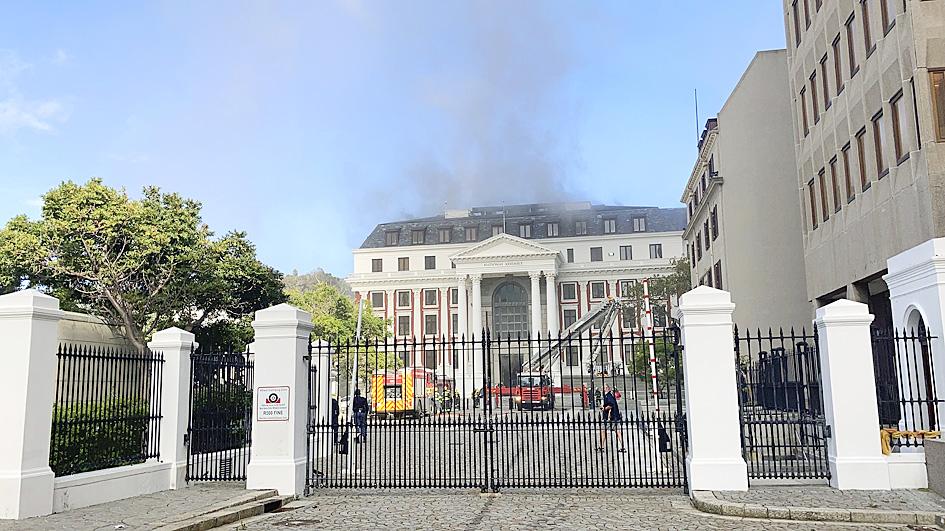A massive fire in South Africa’s Houses of Parliament in Cape Town caused the roof of the old National Assembly building to collapse yesterday as the blaze continued to rage after eight hours.
No causalities have been reported in the fire, which has also spread to the wing housing the current National Assembly, where parliament sits.
“The roof of the old assembly building has collapsed and is gone,” Jean-Pierre Smith, Cape Town’s mayoral committee member for safety and security, told reporters.

Photo: AP
The cause of the fire was not yet known, but an investigation was opened.
South African President Cyril Ramaphosa told reporters at the scene that an arrest had been made.
“Someone has been held right now and is being questioned,” he said.
The historic building houses a collection of rare books and the original copy of the former Afrikaans national anthem Die Stem Van Suid-Afrika (“The Voice of South Africa”), which was already damaged.
“The entire building has suffered extensively smoke and water damage,” Smith said, adding that “the fire has not been contained.”
It started at about 5am in the parliament complex’s oldest wing, which was completed in 1884 and has rooms covered in wood where parliamentarians once sat.
It then spread to newer parts of the complex that remain in use.
“Firefighters are currently trying to control the fire in the new wing, where the fire has affected the National Assembly Chamber,” parliamentary spokesman Moloto Mothapo told an online news conference.
The imposing red and white building was still shrouded in a thick cloud of black at midday.
A team of firefighters who were first to arrive at the scene battled the flames for several hours before being forced to retreat and call for reinforcements.
About 70 firefighters were later deployed, some using a crane to spray water on the blaze.
Former Cape Town mayor and current South African Minister of Public Works and Infrastructure Patricia de Lille said it would still be several hours before the fire was brought under control.
Inside the rooms, fine showers of gray ash fell from the ceiling to the floor, which was already littered with debris.
Emergency services feared the fire could spread swiftly through the old rooms, which are decorated with wood, thick carpets and curtains.
Images broadcast on television had earlier shown giant flames leaping from the roof.
The area around the fire in the upmarket neighborhood was quickly cordoned off.

WAITING GAME: The US has so far only offered a ‘best rate tariff,’ which officials assume is about 15 percent, the same as Japan, a person familiar with the matter said Taiwan and the US have completed “technical consultations” regarding tariffs and a finalized rate is expected to be released soon, Executive Yuan spokeswoman Michelle Lee (李慧芝) told a news conference yesterday, as a 90-day pause on US President Donald Trump’s “reciprocal” tariffs is set to expire today. The two countries have reached a “certain degree of consensus” on issues such as tariffs, nontariff trade barriers, trade facilitation, supply chain resilience and economic security, Lee said. They also discussed opportunities for cooperation, investment and procurement, she said. A joint statement is still being negotiated and would be released once the US government has made

Authorities have detained three former Taiwan Semiconductor Manufacturing Co (TMSC, 台積電) employees on suspicion of compromising classified technology used in making 2-nanometer chips, the Taiwan High Prosecutors’ Office said yesterday. Prosecutors are holding a former TSMC engineer surnamed Chen (陳) and two recently sacked TSMC engineers, including one person surnamed Wu (吳) in detention with restricted communication, following an investigation launched on July 25, a statement said. The announcement came a day after Nikkei Asia reported on the technology theft in an exclusive story, saying TSMC had fired two workers for contravening data rules on advanced chipmaking technology. Two-nanometer wafers are the most

NEW GEAR: On top of the new Tien Kung IV air defense missiles, the military is expected to place orders for a new combat vehicle next year for delivery in 2028 Mass production of Tien Kung IV (Sky Bow IV) missiles is expected to start next year, with plans to order 122 pods, the Ministry of National Defense’s (MND) latest list of regulated military material showed. The document said that the armed forces would obtain 46 pods of the air defense missiles next year and 76 pods the year after that. The Tien Kung IV is designed to intercept cruise missiles and ballistic missiles to an altitude of 70km, compared with the 60km maximum altitude achieved by the Missile Segment Enhancement variant of PAC-3 systems. A defense source said yesterday that the number of

Taiwanese exports to the US are to be subject to a 20 percent tariff starting on Thursday next week, according to an executive order signed by US President Donald Trump yesterday. The 20 percent levy was the same as the tariffs imposed on Vietnam, Sri Lanka and Bangladesh by Trump. It was higher than the tariffs imposed on Japan, South Korea and the EU (15 percent), as well as those on the Philippines (19 percent). A Taiwan official with knowledge of the matter said it is a "phased" tariff rate, and negotiations would continue. "Once negotiations conclude, Taiwan will obtain a better